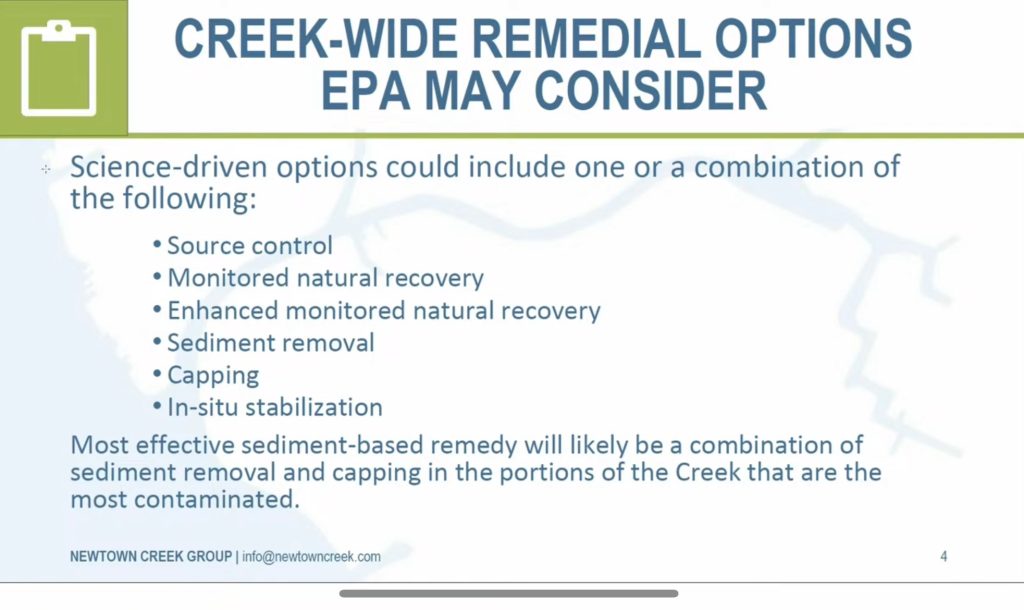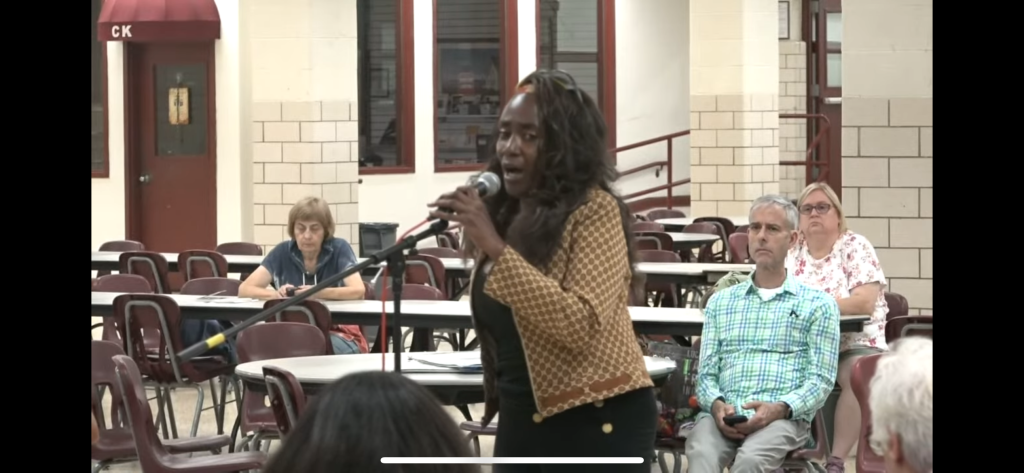
Courtesy CB5
At the CB5 meeting, David Haury provided an update on the ongoing cleanup efforts at the Newtown Creek Superfund site, detailing significant contamination issues and current remediation plans.
MOHAMED FARGHALY
mfarghaly@queensledger.com
The latest Community Board 5 meeting brought forward a range of local concerns and initiatives, including community safety, cycling activities, and legal system outreach. The meeting featured speakers from diverse backgrounds, each addressing important issues impacting the community.
At the meeting held on Sept 10, David Haury, Senior Associate at Anchor QEA, provided a detailed update on the Newtown Creek Superfund site, shedding light on ongoing cleanup efforts and future plans for one of New York City’s most polluted waterways. Haury represents the Newtown Creek group, a coalition of industrial parties working under the EPA’s direction to address the contamination issues at the site.
“We are involved in the Superfund site at Newtown Creek, and I’d like to brief you tonight on the progress and upcoming steps in the cleanup process,” Haury said.
Haury explained that Newtown Creek was designated a Superfund site by the United States Environmental Protection Agency (EPA) in 2010. This designation triggered a comprehensive investigation to determine the extent of contamination and the associated risks.
“As some of you may know, Newtown Creek, in its entirety, was listed as a Superfund site in 2010 by the United States Environmental Protection Agency that sets off a comprehensive investigation of the creek and leads to decisions about remedies. I want to talk to you a little bit about where we are in that process,” Haury said.
The remedial investigation concluded about two years ago, revealing significant contamination primarily through the ingestion of fish and crabs from the creek.
“It was concluded that there are unacceptable risk to human health, that we are to human health primarily through ingestion of fish and crabs they’re caught and consumed from the creek,” Haury said.
Following the investigation, the EPA initiated a feasibility study to explore various cleanup alternatives. Haury focused on the ongoing remediation efforts in the East Branch, a tributary of Newtown Creek identified as one of the most contaminated areas.
The selected remedy for the East Branch, known as EB-D, involves a combination of sediment removal, capping, and long-term monitoring.

The remedy includes removing contaminated sediments, placing an engineering cap over the area, and establishing a long-term monitoring program to ensure effectiveness and address ongoing contamination sources.
Haury emphasized the Newtown Creek group’s commitment to transparency and community engagement.
Addressing questions from the audience, Haury discussed the potential use of various remediation technologies and future plans. He clarified that while the current focus is on sediment removal and capping, other methods like aeration systems may be employed in the future based on evolving needs and conditions.
The aeration system, which was implemented to address oxygen levels in the creek, will continue to operate during remediation activities and be adjusted as necessary.
A representative from the local cycling group, Tammy Green of the Jackie Robinson Parkway Security Block Watch Association, detailed the organization’s dedication to advocating for cycling as both a healthy and eco-friendly transportation option. The group hosts community bike rides every Thursday at 7 p.m. and every other Saturday at 11 a.m. This Saturday, the group will travel to Park Slope for an annual bike jumble, which is essentially a bike flea market featuring custom bike parts and accessories.
Green also expressed gratitude to the board for their support in improving access to Highland Park. Green highlighted the safety concerns for cyclists and pedestrians navigating the area.
Tammy Green’s presentation was followed with her concerns about recent incidents of violence and the need for increased public safety measures in Highland Park.
“Unfortunately, we had a murder on July 5 in Highland Park, and one month went by and no one in the Parks Department knew about it,” Green said. “Public safety is a human right, when visiting any of our parks in the five boroughs in New York City, no one should anticipate being killed when visiting a park.”
Green urged Community Board 5 to advocate for enhanced park enforcement and improved safety measures.
“We’re asking for increased Park enforcement so that people can enjoy the beautiful scenery, including the reservoir and other great programs,” Green said.
Highland Park also has a program which provides urban youth with opportunities for education and scholarships. Green also called for attention to other issues, including tree maintenance and the installation of security cameras.
Jasmine Valle, a Principal Court Attorney from the Unified Court System Queens Equal Justice, shared information about an upcoming community event.
“This month, we will be hosting a Hispanic Heritage Month program that will be open to the public,” Valle said. “The event is scheduled for September 18 at 1 p.m. in front of the Queens Supreme Court Civil Court Building at 88-11 Stuphin Blvd. We’ll have a live band and will be distributing free icees for free on a first-come, first-served basis,” she said.
The meeting also featured a resident raising concerns about a significant sewer issue. “I’ve had to pay $16,000 to fix a problem on my block due to the lack of sewer services,” the resident explained. They sought assistance from the board to address the ongoing issue and alleviate the financial burden.
For more information on upcoming community events and initiatives, residents can visit the Community Board 5 website at nyc.gov/site/queenscb5/about/contact.page or attend future board meetings.

Courtesy CB5
Tammy Green of the Jackie Robinson Parkway Security Block Watch Association highlighted the need for increased public safety measures in Highland Park.


